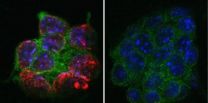(Press-News.org) PHILADELPHIA - The hormone prolactin is produced by the pituitary gland in the brain and then travels via the bloodstream to cells throughout the body, where it exerts multiple reproductive and metabolic effects, most notably on the breast where it is the master regulator of lactation. In recent years researchers have found that prolactin is also produced by some tissues outside the brain, however little is known about the functions of extra-pituitary prolactin or how its production is regulated in these tissues.
Now, the laboratory of Lewis A. Chodosh, MD, PhD, chair of the Department of Cancer Biology at the Perelman School of Medicine, University of Pennsylvania, reports in Genes & Development that activation of the PI3K-Akt oncogenic signaling pathway in the mammary glands of mice rapidly induces cells in the breast itself to produce prolactin. This, in turn, triggers Stat5 activation, mammary epithelial differentiation and milk production in virgin mice within a matter of hours.
"Remarkably, these changes occur in the absence of any of the complex hormonal changes or developmental programs that normally accompany pregnancy" explains Chodosh.
Consistent with a physiological role for prolactin outside of the brain, the Penn team found that mice bearing mutant Akt genes fail to activate Stat5 or initiate lactation when they give birth due to an inability to synthesize and secrete prolactin in the mammary gland, despite normal levels of circulating prolactin in the blood.
These findings provide the first demonstration that the synthesis and secretion of mammary gland prolactin is regulated by PI3K-Akt signaling and identify a physiological function for extra-pituitary prolactin during a critical developmental stage that is essential for the survival of mammalian offspring.
What's more, prolactin has long been thought to play a role in human breast cancer, however this has typically been assumed to be due to circulating prolactin produced by the pituitary. Since the PI3K-Akt signaling pathway is commonly activated in human cancers, this new finding suggests the important possibility that prolactin produced by the breast itself may play a role in breast cancer. In fact, mammary prolactin has been detected in some human breast cancers. As such, investigators have proposed that prolactin produced by the mammary gland – rather than by the pituitary – may play a direct role in the development of breast cancer, for example by providing pro-growth or pro-survival signals to cancer cells in the breast. Accordingly, anti-cancer drugs aimed at blocking the effects of prolactin are currently under development.
"Since the PI3K-Akt pathway is one of the most commonly activated oncogenic pathways in human cancer, its identification as an upstream regulator of prolactin production in the mammary gland has intriguing potential implications for understanding the pathology of human breast cancer and as well as improving its treatment," notes Chodosh.
INFORMATION:
Co-authors are Chien-Chung Chen, Douglas B. Stairs, Robert B. Boxer, George K. Belka, and James V. Alvarez, all from Penn and Nelson D. Horseman, from the University of Cincinnati. This research was supported in part by grants from the National Cancer Institute U01 CA105490 and R01 CA098371, the Department of Defense Breast Cancer Research Program, and the Breast Cancer Research Foundation.
Penn Medicine is one of the world's leading academic medical centers, dedicated to the related missions of medical education, biomedical research, and excellence in patient care. Penn Medicine consists of the Raymond and Ruth Perelman School of Medicine at the University of Pennsylvania (founded in 1765 as the nation's first medical school) and the University of Pennsylvania Health System, which together form a $4.3 billion enterprise.
The Perelman School of Medicine is currently ranked #2 in U.S. News & World Report's survey of research-oriented medical schools. The School is consistently among the nation's top recipients of funding from the National Institutes of Health, with $479.3 million awarded in the 2011 fiscal year.
The University of Pennsylvania Health System's patient care facilities include: The Hospital of the University of Pennsylvania -- recognized as one of the nation's top "Honor Roll" hospitals by U.S. News & World Report; Penn Presbyterian Medical Center; and Pennsylvania Hospital — the nation's first hospital, founded in 1751. Penn Medicine also includes additional patient care facilities and services throughout the Philadelphia region.
Penn Medicine is committed to improving lives and health through a variety of community-based programs and activities. In fiscal year 2011, Penn Medicine provided $854 million to benefit our community.
New insights on control of pituitary hormone outside of brain has implications for breast cancer
2012-10-01
ELSE PRESS RELEASES FROM THIS DATE:
Fish getting smaller as the oceans warm: UBC research
2012-10-01
Changes in ocean and climate systems could lead to smaller fish, according to a new study led by fisheries scientists at the University of British Columbia.
The study, published today in the journal Nature Climate Change, provides the first-ever global projection of the potential reduction in the maximum size of fish in a warmer and less-oxygenated ocean.
The researchers used computer modeling to study more than 600 species of fish from oceans around the world and found that the maximum body weight they can reach could decline by 14-20 per cent between years 2000 and ...
Researchers discover key mechanism for controlling the body's inflammatory response
2012-10-01
Researchers at Queen Mary, University of London have discovered how a key molecule controls the body's inflammatory responses. The molecule, known as p110delta, fine-tunes inflammation to avoid excessive reactions that can damage the organism. The findings, published in Nature Immunology today (30 September), could be exploited in vaccine development and new cancer therapies.
A healthy immune system reacts to danger signals – from microorganisms such as bacteria and viruses, or from the body's own rogue cells, such as cancer cells. This tightly controlled reaction starts ...
Researchers discover gene that causes deafness
2012-10-01
CINCINNATI—Researchers at the University of Cincinnati (UC) and Cincinnati Children's Hospital Medical Center have found a new genetic mutation responsible for deafness and hearing loss associated with Usher syndrome type 1.
These findings, published in the Sept. 30 advance online edition of the journal Nature Genetics, could help researchers develop new therapeutic targets for those at risk for this syndrome.
Partners in the study included the National Institute on Deafness and other Communication Disorders (NIDCD), Baylor College of Medicine and the University of ...
New pathogen epidemic identified in sub-Saharan Africa
2012-10-01
A new study out today (Sunday 30 September) reveals that the emergence and spread of a rapidly evolving invasive intestinal disease, that has a significant mortality rate (up to 45%) in infected people in sub-Saharan Africa, seems to have been potentiated by the HIV epidemic in Africa.
The team found that invasive non-Typhoidal Salmonella (iNTS) disease is caused by a new form of the bacteria Salmonella Typhimurium that has spread from two different focal hubs in Southern and Central Africa beginning 52 and 35 years ago, respectively. They also found that one of the ...
Climate change could cripple southwestern forests
2012-10-01
Combine the tree-ring growth record with historical information, climate records, and computer-model projections of future climate trends, and you get a grim picture for the future of trees in the southwestern United States. That's the word from a team of scientists from Los Alamos National Laboratory, the U.S. Geological Survey, the University of Arizona, and other partner organizations.
If the Southwest is warmer and drier in the near future, widespread tree death is likely and would cause substantial changes in the distribution of forests and of species, the researchers ...
Common RNA pathway found in ALS and dementia
2012-10-01
Two proteins previously found to contribute to ALS, also known as Lou Gehrig's disease, have divergent roles. But a new study, led by researchers at the Department of Cellular and Molecular Medicine at the University of California, San Diego School of Medicine, shows that a common pathway links them.
The discovery reveals a small set of target genes that could be used to measure the health of motor neurons, and provides a useful tool for development of new pharmaceuticals to treat the devastating disorder, which currently has no treatment or cure.
Funded in part by ...
The genetics of white finger disease
2012-10-01
Vibration-induced white finger disease (VWF) is caused by continued use of vibrating hand held machinery (high frequency vibration >50 Hz), and affects tens of thousands of people. New research published in BioMed Central's open access journal Clinical Epigenetics finds that people with a genetic polymorphism (A2191G) in sirtuin1 (SIRT1), a protein involved in the regulation of endothelial NOS (eNOS), are more likely to suffer from vibration-induced white finger disease.
VWF (also known as hand arm vibration syndrome (HAVS)) is a secondary form of Raynaud's disease involving ...
Breast cancer recurrence defined by hormone receptor status
2012-10-01
Human epidermal growth factor (HER2) positive breast cancers are often treated with the same therapy regardless of hormone receptor status. New research published in BioMed Central's open access journal Breast Cancer Research shows that women whose HER2 positive cancer was also hormone (estrogen and progesterone) receptor (HR) negative had an increased risk of early death, and that their cancer was less likely to recur in bone than those whose cancer retained hormone sensitivity.
Breast cancer is a heterogeneous disease with many different subtypes. HR positive cancer ...
Scientists find missing link between players in the epigenetic code
2012-10-01
CHAPEL HILL, N.C. – Over the last two decades, scientists have come to understand that the genetic code held within DNA represents only part of the blueprint of life. The rest comes from specific patterns of chemical tags that overlay the DNA structure, determining how tightly the DNA is packaged and how accessible certain genes are to be switched on or off.
As researchers have uncovered more and more of these "epigenetic" tags, they have begun to wonder how they are all connected. Now, research from the University of North Carolina School of Medicine has established ...
Blocking key protein could halt age-related decline in immune system, Stanford study finds
2012-10-01
STANFORD, Calif. — The older we get, the weaker our immune systems tend to become, leaving us vulnerable to infectious diseases and cancer and eroding our ability to benefit from vaccination. Now Stanford University School of Medicine scientists have found that blocking the action of a single protein whose levels in our immune cells creep steadily upward with age can restore those cells' response to a vaccine.
This discovery holds important long-term therapeutic ramifications, said Jorg Goronzy, MD, PhD, professor of rheumatology and immunology and the senior author of ...



